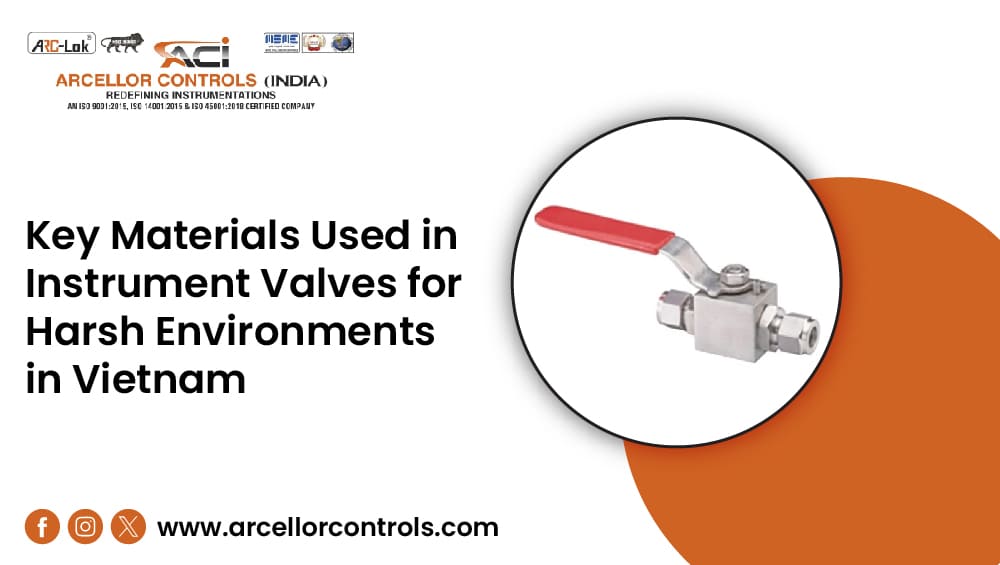Call us 8:00am - 8:00pm
079-2273 3345 / 6353949804
Monday to Friday
8:00am - 8:00pm

Key Materials Used in Instrument Valves for Harsh Environments in Vietnam
Instrumentation valves possess the unique ability to control the flow of liquids and gases with precision, safety, and effectiveness. These valves serve as a crucial component of all modern industrial applications and processes. Arcellor Controls specializes in the production of premium instrumentation valves for various industries in India and worldwide. On the basis of our expertise, we have created this guide, which will help you assess instrument valve materials in the harsh environment of Vietnam industries. We will also discuss the use and importance of instrumentation valves and how they maximize system efficiency, improve safety, and assure effective functioning.What Are Instrumentation Valves?
Instrumental valves are precision-engineered so that they can separate, manage, or monitor the flow of gases or liquids in the pipelines. They have an application in various important industrial sectors. Some of these industries are chemical processing, oil and gas, and pharmaceuticals. These valves preserve the system’s integrity and security.What are the top 10 types of instrumentation valves?
-
Ball Valves
-
Needle Valves
-
Check Valves
-
Gate Valves
-
Global Valves
-
Butterfly valves
-
Diaphragm Valves
-
Plug Valves
-
Pinch Valves
-
Pressure relief valves
How Do Instrumentation Valves Work?
Instrumentation valves are sophisticated devices that are used in a variety of industrial operations to regulate the flow of liquids and gases. This is a brief explanation of their way of operation:-
Valve body
-
Valve Stem
-
Valve Plug or Disc
-
Valve Seat
-
Actuator
How harsh are the conditions of the Vietnam industry for instrumentation valves?
The industrial settings and environment of Vietnam industries are very challenging because of a combination of operational, process, and environmental variables. These are some of the factors that make the situation harsh:-
Corrosive coastal environment
-
Industrial procedures at high temperatures
-
Constantly exposed to chemicals
-
Pressure extremes
-
Slurry and particulate media
-
Monsoon and flooding risks
Which are the High-Performance Materials used for Instrument Valves in Adverse Vietnamese Settings?
Manufacturers use a wide range of materials to produce instrumentation valves. They select the material on the basis of the qualities that they offer and the customer’s requirements for the level of robustness and resilience to heat, corrosion, and pressure requirements. Stainless steel, brass, and different plastics are common materials that industries choose. Materials for Valve Bodies-
Stainless Steel
-
Brass
-
Cast iron
-
Polymers
Materials for Valve Internal Components (Trim):
-
Valve Stem
-
Valve seat
-
Gaskets and seals
What are the aspects that you should take into account when selecting a material?
1. Corrosion resistance
Special alloys or stainless steel are the best when you want to apply the instrumentation valve in applications that have corrosive fluids.2. High pressure and temperature
If the industry has high-pressure and extreme temperature conditions, then you might need carbon steel, stainless steel, or exotic alloys3. Cost
If you are looking for a budget-friendly option in an industrial application that has less demanding corrosive, pressure, and thermal requirements, brass can be a good option.Conclusion
Instrumentation valves in Vietnam have to handle the highly unpredictable environment and withstand high salinity, humidity, chemical aggression, pressure swings, heat, and degradation. Therefore, the material choice is very important to ensure longevity and consistent performance. PTFE, Inconel, Duplex, Monel, and stainless steel 316L are some of the ideal materials in the Vietnam industries. They are high-temperature valve materials and chemical‑resistant valve components. Arcellor Controls is a well-recognized manufacturer of instrument valves all over the world. We supply instrument valve materials specially for harsh Vietnam conditions. You can buy products with duplex valve materials and corrosion-resistant valve materials for Vietnam Environment. We also have Super duplex instrumentation valves and valves with PTFE seal valve materials.Get in Touch
You will find yourself working in a true partnership that results in an incredible experience, and an end product that is the best.





Post A Comment